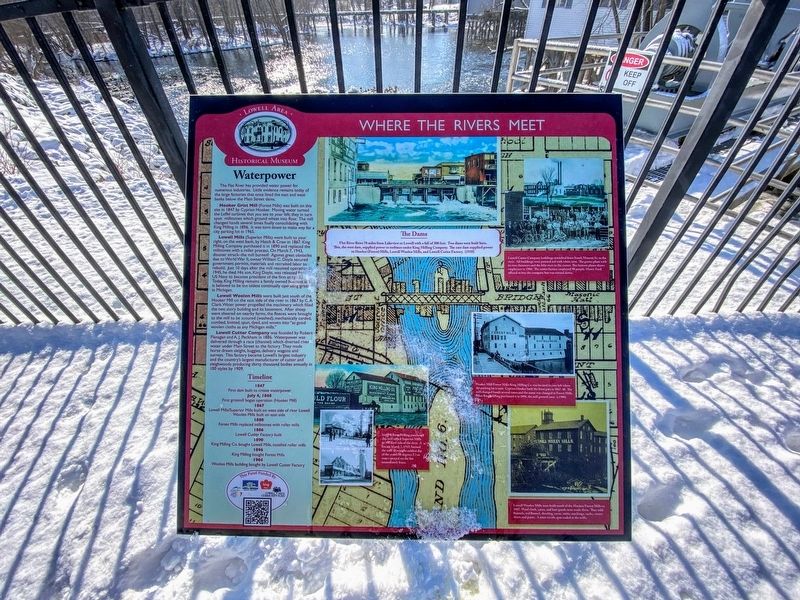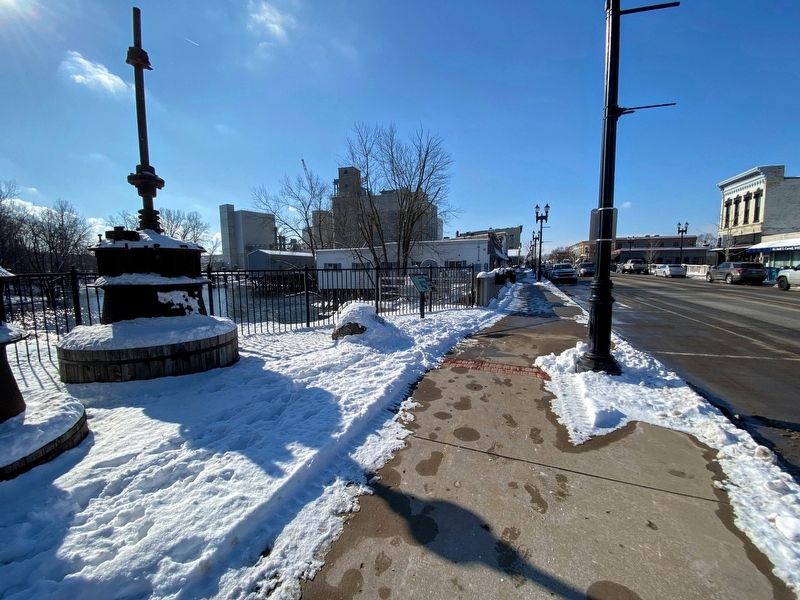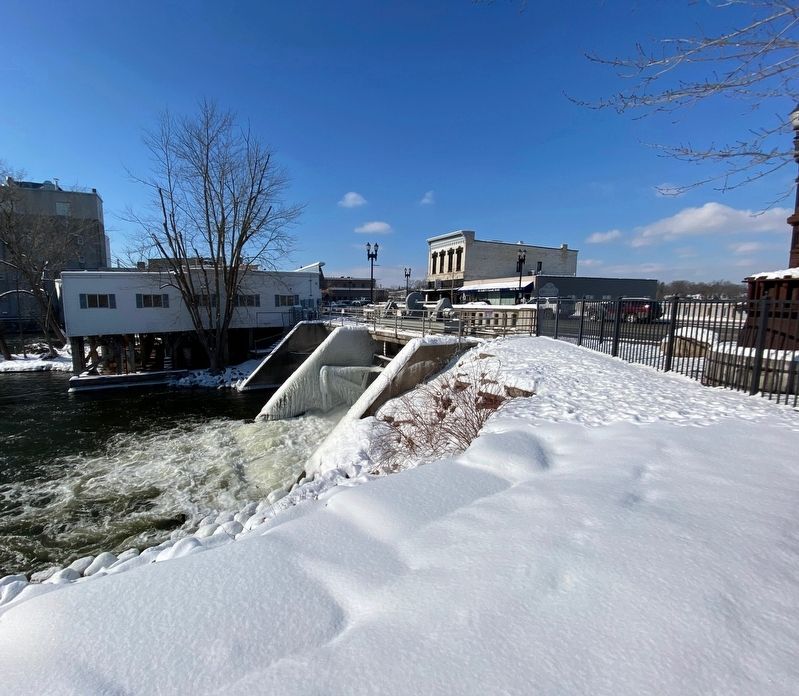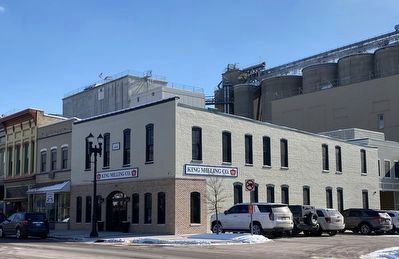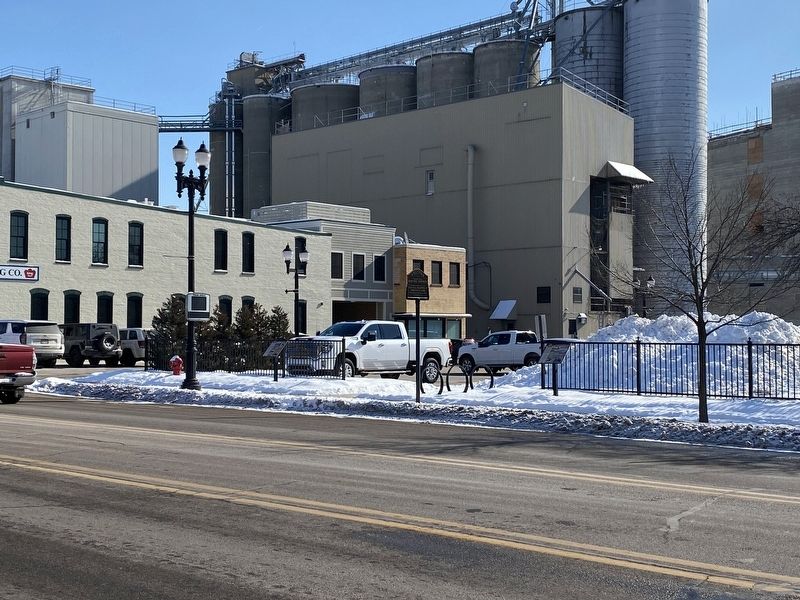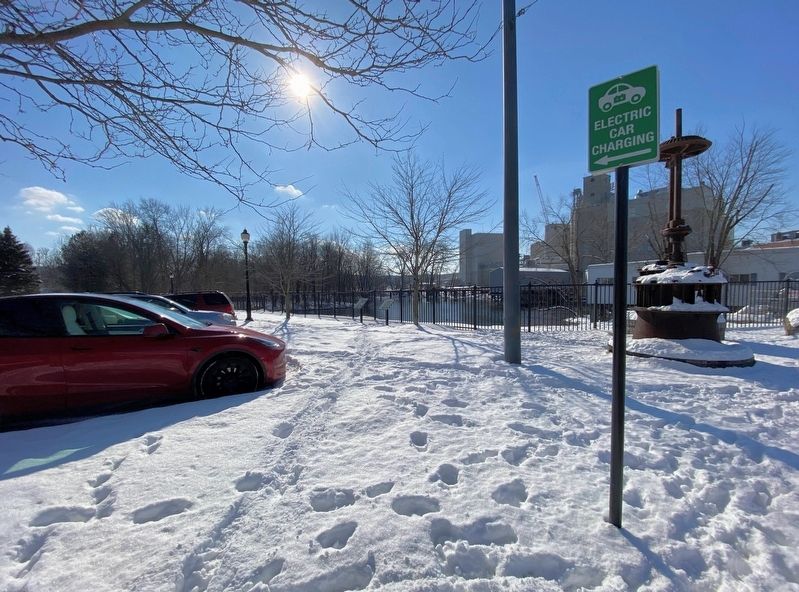Vergennes Township in Lowell in Kent County, Michigan — The American Midwest (Great Lakes)
Waterpower
Where The Rivers Meet
Hooker Grist Mill (Forest Mills) was built on this site in 1847 by Cyprian Hooker. Moving water turned the Leffel turbines that you see to your left; they in turn spun millstones which ground wheat into flour. The mill changed hands several times finally consolidating with King Milling in 1896. It was torn down to make way for a city parking lot in 1965.
Lowell Mills (Superior Mills) were built to your right, on the west bank, by Hatch & Craw in 1867. King Milling Company purchased it in 1890 and replaced the millstones with a roller process. On March 7, 1943, disaster struck—the mill burned! Against great obstacles due to World War Il, owner William C. Doyle secured government permits, materials and recruited labor to rebuild. Just 10 days after the mill resumed operation in 1945, he died. His son, King Doyle, was released from the US Navy to become president of the firm at age 23. 3. Today, King Milling remains a family owned business and is believed to be the oldest continually operating gristmill in Michigan.
Lowell Woolen Mills were built just south of the Hooker Mill on the east side of the river in 1867 by C.A Clark. Water power propelled the machinery which filled the two story building and its basement. After sheep were sheared on nearby farms, the fleeces were brought to the mill to be scoured (washed), mechanically carded, combed, knitted, spun, dyed, and woven into "as good woolen cloths as any Michigan mills."
Lowell Cutter Company was founded by Robert Flanagan and A J. Peckham in 1886. Waterpower was delivered through a race (channel) which diverted river water under Main Street to the factory. They made horse drawn sleighs, buggies, delivery wagons and surreys. This factory became Lowell's largest industry and the country's largest manufacturer of cutter and sleighwoods producing thirty thousand bodies annually in 100 styles by 1909.
Timeline
1847
First dam built to create waterpower
July 4, 1848
First gristmill began operation (Hooker Mill)
1867
Lowell Mills/Superior Mills built on west side of river Lowell Woolen Mills built on east side
1880
Forest Mills replaced millstones with roller mills
1886
Lowell Cutter Factory built
1890
King Milling Co. bought Lowell Mills, installed roller mills
1896
King Milling bought Forest Mills
1904
Woolen Mills building bought by Lowell Cutter Factory
The Dams
Flat river flows 70 miles from Lakeview to Lowell with a fall of 300 feet. Two dams were built here. This, the west dam, supplied power to turbines under King Milling Company. The east dam supplied power to Hooker (Forest) Mills, Lowell Woolen Mills, and Lowell Cutter Factory. (1939)
In 1890 King Milling purchased this mill called Superior Mills on the west side of the river. A fire on March 7, 1943, burned the mill. It was the coldest day of the year (-15 degrees F) so water sprayed on the fire immediately froze.
Lowell Cutter Company buildings stretched from South Monroe St. to the river. All buildings were painted red with white trim. The power plant with its two chimneys and the iln were in the center. The bottom photo shows employees in 1904. The cutter factory employed 90 people. Henry Ford offered to buy the company but was turned down.
Hooker Mill/Forest Mills/King Milling Co. was located to your left where the parking lot is now. Cyprian Hooker bult the front part in 1847-48. The mill changed hands several times and the name was changed to Forest Mills. After King Milling purchased it in 1896, the mill ground corn. (c1908)
Lowell Woolen Mills were built south of the Hooker/Forest Mills in 1867. Wool cloth, yarns, and knit good were made there. They sold flannels, red flannel, sheeting, yarns, mitts, stockings, socks, winter shirts and pants. A train trestle spur ended at the mills.
Erected by Lowell Area Historical Museum.
Topics. This historical marker is listed in these topic lists: Industry & Commerce • Settlements & Settlers • Waterways & Vessels. A significant historical year for this entry is 1847.
Location. 42° 56.059′ N, 85° 20.291′ W. Marker is in Lowell, Michigan, in Kent County. It is in Vergennes Township. Marker is on East Main Street (Michigan Route 21) near South Monroe Street Southeast. Touch for map. Marker is at or near this postal address: 96 East Main Street, Lowell MI 49331, United States of America. Touch for directions.
Other nearby markers. At least 8 other markers are within walking distance of this marker. Clamming and the Button Factory (a few steps from this marker); Island Park (a few steps from this marker); Lowell Veterans Memorial (within shouting distance of this marker); On The Bridge (within shouting distance of this marker); Lowell Area Veterans Memorial (within shouting distance of this marker); Negonce Block and Bank Block (within shouting distance of this marker); Welcome to Lowell (within shouting distance of this marker); Early Settlers (about 300 feet away, measured in a direct line). Touch for a list and map of all markers in Lowell.
Credits. This page was last revised on February 26, 2023. It was originally submitted on February 21, 2023, by J.T. Lambrou of New Boston, Michigan. This page has been viewed 38 times since then and 11 times this year. Photos: 1, 2, 3, 4, 5, 6. submitted on February 21, 2023, by J.T. Lambrou of New Boston, Michigan. • J. Makali Bruton was the editor who published this page.
